ArchBook: Architectures of the Book

Published 7 May 2012Corrected and updated 20 January 2022
Although their specific design varies from book to book, flaps are typically defined as the parts of a page Page one side of a leaf. See: Recto Leaf Verso PDF Pagina Layout Pagination CLOSE or ESC used to conceal text, illustration, or a combination of both. The fugitive sheets or fugitive leaves found in some early anatomy texts, for example, are generally comprised of separate pieces of paper that are pasted and arranged to depict various layers of viscera. Readers of such books lift or separate these flaps to reveal the interior anatomy of the human body.1 Flaps found in early children’s literature, on the other hand, are often single sheets of paper folded vertically along the top and bottom with vertical slits cut into both sides to create four separate sections;2 readers simply lift each flap to reveal the next part of the story. While the exact construction of each flap may differ from one text to another, their function remains basically the same: flaps are designed to reveal things that are not immediately apparent on the page itself.
While some flaps are designed to conceal information, and thus compel the reader to reveal the text or illustrations beneath, other flaps organize information into logical layers. Early anatomy texts, including the famous examples by Vesalius, Descartes, and Remmelin, depict body parts, bones, muscles, nerves, and internal organs using superimposed flaps that are drawn and shaped to represent specific elements of human anatomy. Some of these flaps, in particular Descartes’s image of a human heart and Remmelin’s rendition of a pregnant womb, are meticulously rendered. The reader is thus given the tactile experience of grasping the organ itself.
Flaps are often discussed in connection with other movable parts found in books. This is due partly to the fact that they emerged roughly in the same period as volvelles Volvelle consists of one or more layers of parchment or paper discs or other segments fastened to a leaf, allowing for each individual layer to be rotated independently of the other components. See the ArchBook essay Volvelles for more details. CLOSE or ESC and pop-ups Pop-up term often used to describe a three-dimensional paper construction found in books. Also used as a generic marker for books containing such constructions, i.e., "pop-up books." See: Paper CLOSE or ESC. In the sixteenth and seventeenth centuries, books with moveable parts were primarily academic in nature; by the eighteenth century, publishers expanded their reach to the burgeoning children’s entertainment market.3 This entry will consider examples of books produced between 1543 and 1907 from a wide range of genres, including geometry and anatomy textbooks, landscaping treatises, and children’s literature.
Flaps are ideal for explaining subjects that require three-dimensional imagery. Abstract concepts, such as geometrical shapes, can therefore be better experienced through the use of flaps. Henry Billingsley’s English translation of Euclid’s The Elements of Geometrie is an early example of a book containing pop-ups.4 First printed in English by John Day, the publication of The Elements of Geometrie (London, 1570) was delayed, in large part, because of the technical demands required to produce its numerous complex figures.5 Unlike other editions of Euclid, which only use two-dimensional sketches to explain mathematical concepts, thirty-two of the figures found in Day’s imprint are pop-up constructions: two-dimensional diagrams of pyramids and cubes are printed on flaps that the reader folds together to create three-dimensional renderings.6 The flaps used in Elements thus play a vital role in allowing readers to tangibly understand solid geometry (see fig. 1).
The flaps in Euclid’s Elements are cut to lie flat, allowing the book to close naturally. Elements thus offers the reader the unique opportunity to view the same shape in two different states—collapsed and fully-formed—without damaging any of the essential components. This use of a simple flap technology to create three-dimensional shapes contributes much to the experience of visualizing difficult mathematical concepts. In this particular example, the interest is not in what lies beneath the flap, but in what can be created through manipulation of it, and in what can be learned about each shape when it is built up and when it is lying flat. The Elements of Geometrie illustrates the potential inherent in three-dimensional description, while also retaining each shape’s two-dimensional counterpart. Through viewing the shape in both states, the reader can better comprehend the larger patterns and principles of geometry.
Figure 1

Click For Larger Image

Geometric Flaps Flaps used to represent 3-dimensional shapes, Euclid's The Elements of Geometrie. Image courtesy of Thomas Fisher Rare Book Library, University of Toronto.CLOSE or ESC
Andreas Vesalius’s 1543 work De humani corporis fabrica librorum (“On the Fabric of the Human Body”) marks the beginning of modern anatomy, since it is the first work to include drawings and descriptions of every part of the human body based on direct observation.7 Prior to Vesalius’s work, and after the publication of his Fabrica, scholars turned to the ancient writer Galen for their anatomical knowledge.8 While Vesalius would cite Galen repeatedly, and often approvingly, throughout his work, he would also argue that Galen based his anatomical assumptions on the physiology of animals rather than humans, and that many of his observations were therefore wrong. Vesalius’s work superseded a centuries-old tradition, and thereby eventually changed the study and teaching of anatomy forever.9
Figure 2
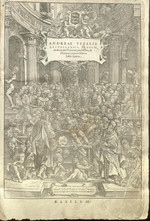
Click For Larger Image

Flaps in VesaliusAndreas Vesalius, De humani corporis fabrica librorum, title page. Image courtesy of Thomas Fisher Rare Book Library, University of Toronto.CLOSE or ESC
Figure 3
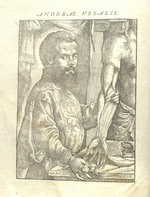
Click For Larger Image
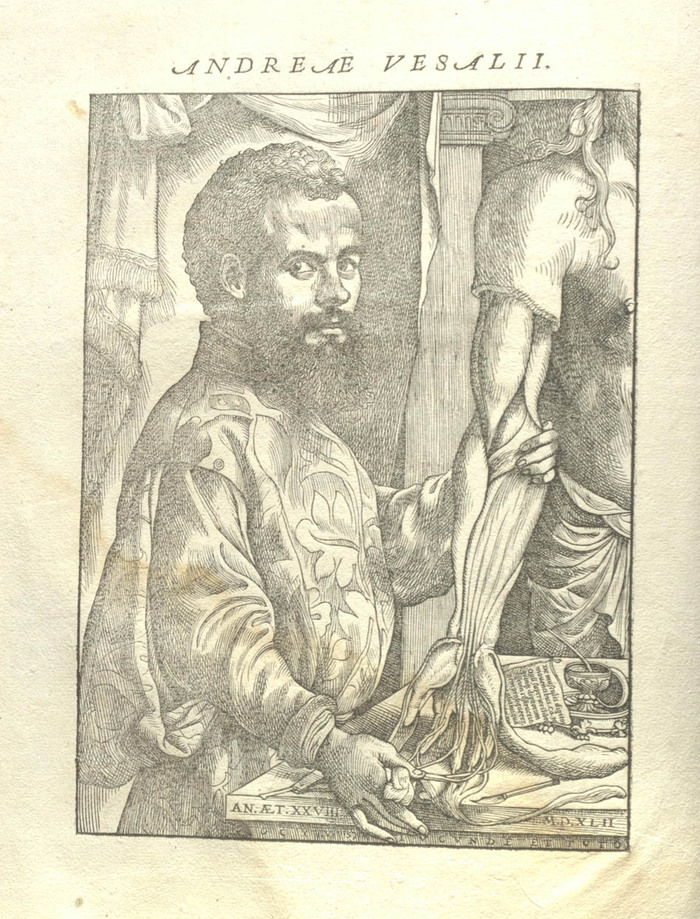
Flaps in VesaliusAndreas Vesalius, De humani corporis fabrica librorum, self-portrait. Image courtesy of Thomas Fisher Rare Book Library, University of Toronto.CLOSE or ESC
Much time, effort, and cost was expended in the creation of this “grand work,”10 which was first printed in Basel by Johannes Oporinus in 1543. Woodcut Woodcut a printed illustration made from a design cut into a block of wood. See: Cut CLOSE or ESC illustrations are featured regularly throughout the more than 700 pages of Oporinus’s folio edition, ranging from illuminated Illuminated a manuscript or early printed book where the margins or initial letters are decorated with flowers or other designs See: Historiated CLOSE or ESC letters, to darkly humorous drawings of cherubs, to full and partial renderings of the human body, to vivid illustrations of dissected viscera.11 This first edition, and some of the subsequent editions of the Fabrica, also incorporated flaps, known as fugitive sheets, that were designed to be carefully separated from each other to reveal multiple layers of internal organs.12 Vesalius believed that these movable images offered readers an opportunity to participate in dissecting the body, while also delighting readers with the beauty of the human form.13 While Vesalius’s fugitive sheets offer only a virtual experience, they nevertheless reflect the process of dissection carried out in anatomy theatres, a process vividly illustrated on the title page and self-portrait of Vesalius’s Fabrica (see figs. 2-3). These fugitive sheets allowed unique interactions between the reader and the text, and may have contributed more to human knowledge of anatomy than Vesalius’s writings have.14 The sense of verisimilitude such flaps enabled is especially present in the rare examples of hand-coloured copies of both Vesalius’s Fabrica and his Epitome, as well as other surviving contemporary anatomical prints with fugitive sheets.15
Various changes were made to each subsequent edition of Fabrica, the most striking of which occurred in the second unauthorized edition of 1552 titled De humani corporis fabrica, lib. VII. At the time of Fabrica’s publication, the French city of Lyon was a hotbed for piracy of popular sixteenth-century books; while the lib. VII is but one of many pirated works published in Lyon, it is a particularly interesting and rare edition.16 Scholar-printer Jean de Tournes tried to capitalize on the widespread success of Fabrica by creating an unauthorized two-volume pocket edition aimed at the student market.17 The changes made to the work are drastic; the image quality is significantly reduced, while all of the flaps and the majority of the drawings have been omitted. Ironically, while de Tournes had hoped to promote his pirated Fabrica to students, the liberties he took with the text destroyed Fabrica’s most useful pedagogical attributes.
Figure 4
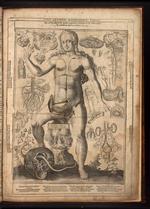
Click For Larger Image
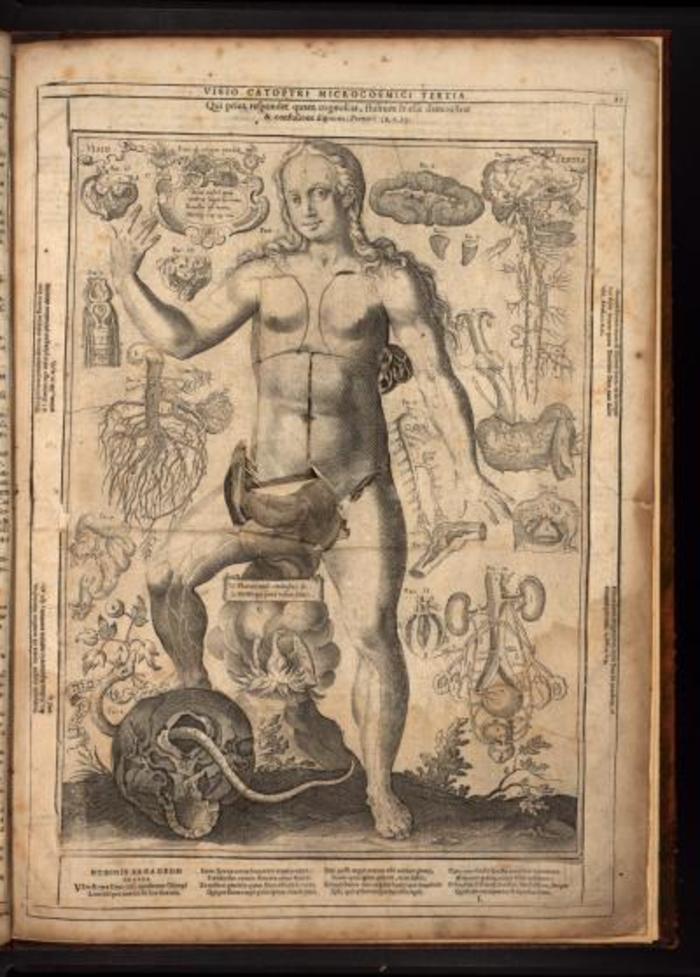
Flaps in Anatomical Text Female anatomy, Johann Remmelin's Catoptrum microcosmicum, first published in 1619. Image courtesy of Thomas Fisher Rare Book Library, University of Toronto, Digital Collections.CLOSE or ESC
Unlike de Tournes, many future designers of anatomical texts followed Vesalius’s example by including flaps in their works. Johann Remmelin’s 1619 Catoptrum microcosmicum, for example, is unsurpassed as an anatomical flapbook, featuring eight separate engraved plates pasted together to make three larger ones.18 The 1619 folio edition follows a 1613 plate series called Catoptri microcosmici with slight simplifications. Remmelin, however, denied his involvement with the 1613 version, even though the engravings by artist Lucas Kilian were based on Remmelin’s own anatomical sketches. The similarities between the two editions are marked enough to refute Remmelin’s claims.19 Presumably, Remmelin hoped to bolster attention to his folio version as a new and important work rather than as simply a reprint of previously published material.20
Like Vesalius, Remmelin used flaps to reveal human anatomy layer by layer, and his flap designs, rendered in both editions by Lucas Kilian, were based on his own drawings (see fig. 4). The title of Remmelin’s work translates roughly to mean “microscopic mirror,” or “man as microcosm,” thus suggesting a metaphysical, rather than simply physiological, dimension behind Remmelin’s approach to anatomy. The drawings testify to this fact, as they are strikingly allegorical. One plate depicts a woman and man on either side of a pregnant female torso, while two others depict a man and a woman respectively, each enhanced by distinctly allegorical imagery. While in some ways Remmelin’s Catoptrum microcosmicum is more aesthetically impressive than Vesalius’s Fabrica, particularly because of its sophisticated use of multi-layered flaps, Remmelin’s folio edition was impractical as a teaching tool, and therefore does not share the same level of historical significance. The sheer size of the book, the delicacy of its flaps, and the cost of purchasing such a magnificent volume prevented the book from being widely used in classrooms;21 however, the 1613 sheets were used in some anatomy theatres including Leiden University.22 Furthermore, by the time the Catoptrum microcosmicum was published, anatomy had shifted away from its former allegorical roots. However, for this very reason Remmelin’s work makes for an interesting anomaly among anatomical works of this period: while visually sophisticated, the work also reverts to a more allegorical conception of the human body, thus placing the work between two different philosophies (science and mythology), and two different understandings of anatomy (pre- and post-Vesalian). This hybridity in Remmelin’s work can be seen in an image where a male figure is shown leaning on an apple that is crushing a snake. The biblical allegory here is obvious, but lifting the flap reveals that the apple conceals a human brain. The female character seen in figures 5 and 6 is shown in a similar position, but the snake, alive and well, has now eaten its way through the apple/brain positioned by the woman’s foot. While depicting the human body in the tradition of Vesalius, Remmelin’s work also incorporates earlier, mythical conceptions of anatomy.
Figure 5

Click For Larger Image

Flaps open in Anatomical Text, 1Remmelin's Catoptrum microcosmicum. Image courtesy of Thomas Fisher Rare Book Library, University of Toronto, Digital Collections.CLOSE or ESC
Figure 6
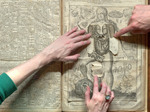
Click For Larger Image
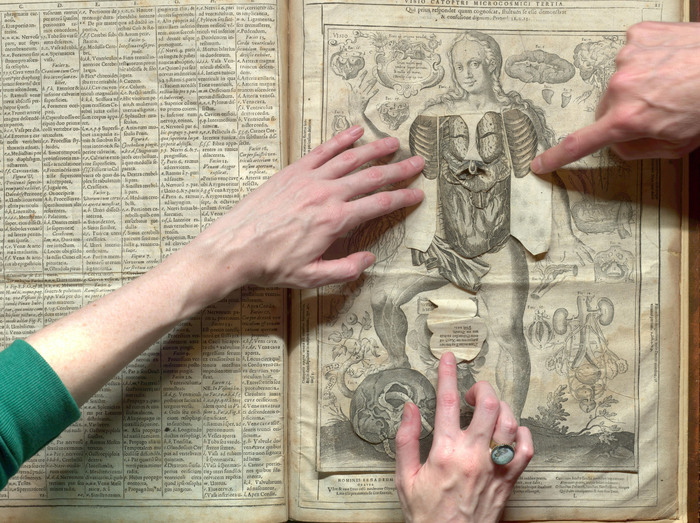
Flaps open in Anatomical Text, 2Remmelin's Catoptrum microcosmicum. Image courtesy of Thomas Fisher Rare Book Library, University of Toronto, Digital Collections.CLOSE or ESC
René Descartes’s De Homine Figuris (“The Treatise of Man”) is another important anatomical work containing flaps. Often considered the first European book on physiology, the work was published in 1662, twelve years after Descartes’s death. Fearing that the work would result in accusations of heresy, Descartes deliberately prevented its publication during his lifetime. De Homine Figuris is famous for its conception of “man as a machine created by God,” and its suggestion that the brain directs the soul; it is also the first work to make reference to involuntary reflex action.23 The work thus marks an important contribution to medical science.
Figure 7
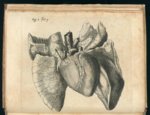
Click For Larger Image
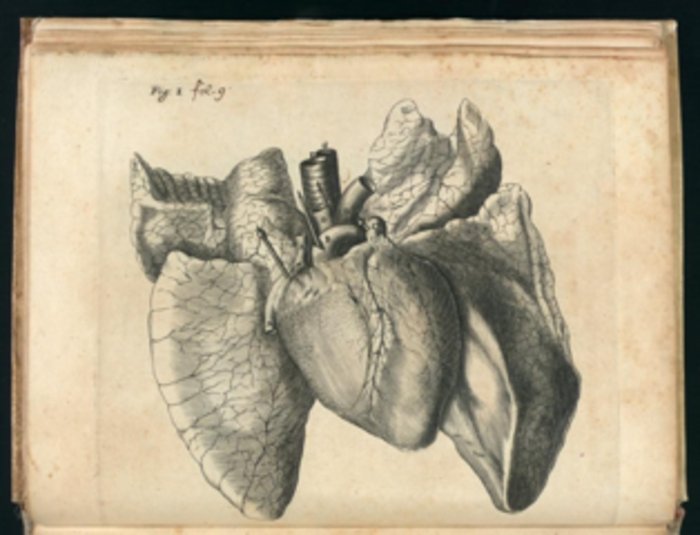
"Heart and Lungs" "Heart and Lungs," from De Homine, René Descartes. Image courtesy of Thomas Fisher Rare Book Library, University of Toronto, Digital Collections.CLOSE or ESC
De Homine Figuris has been praised for its figures and other physical features, including its flaps. Most striking is the book’s full-page illustration of a heart, with flaps representing the outer layers that can be folded back to reveal the inner chambers (see fig. 7). The book also depicts the brain at various stages of dissection, with one diagram incorporating a flap to represent a pineal gland that can be lifted to reveal blood vessels and nerves underneath.24 In these examples, the flaps are part of an elaborate, multi-paged construction.
The use of flaps in anatomy textbooks demonstrates how a physical feature of the book can be used to represent subsurface information, and how such images (representative of viscera and layers of the human anatomy) might be designed in relation to each other. Without actually appearing in three dimensions, these works still grant the reader the opportunity to move deeper and deeper into the body and its organs. The placement of these flaps, then, is just as important as what the flaps depict or disguise.
Complex and delicate flaps such as those used in the Euclid, Vesalius, Remmelin, and Descartes texts are not without technical and practical complications. The flaps demand touch and manipulation, which increases the likelihood of tearing or disintegration; when even a single layer is torn from a scientific text, the intent and effect of the image can be dramatically compromised. The possibility of damage is aggravated by the very format of the codex, the pages of which are pressed together when closed. If a reader neglects to position the flaps carefully before closing the codex, the flaps may fold or twist irreparably.
Figure 8
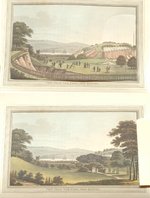
Click For Larger Image
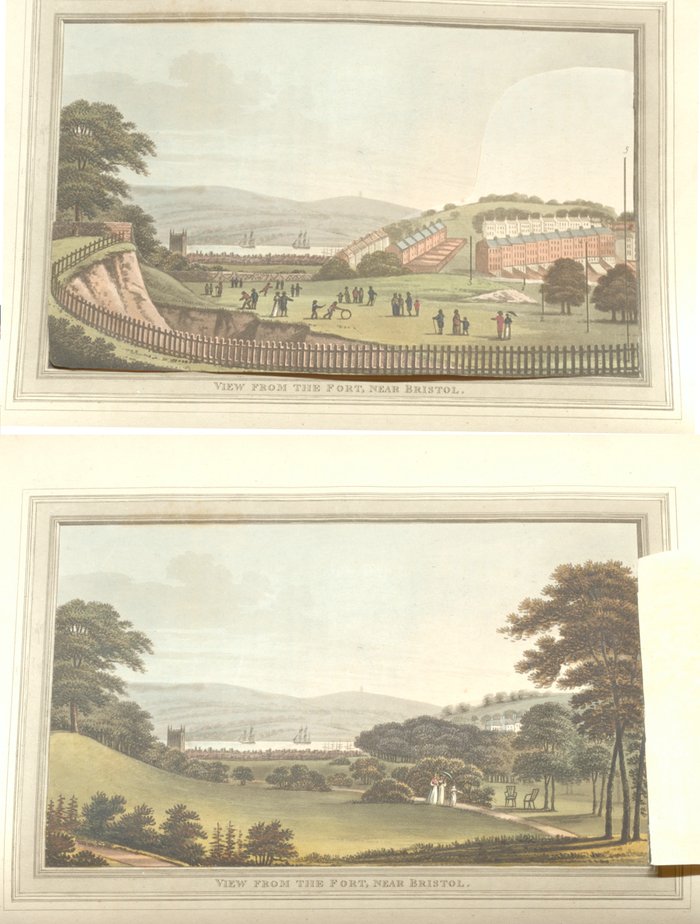
Landscape Flaps Repton's use of flaps to describe his proposal to alter the view from a fort. From Observations on the theory and practice of landscape gardening. Image courtesy of Thomas Fisher Rare Book Library, University of Toronto.CLOSE or ESC
As exemplified by the work of eighteenth-century landscape gardener Humphry Repton, flaps can be useful in illustrating contrasts between “before” and “after” states of a project.25 Repton would provide potential customers with bound “Red Books,” which consisted of watercolour drawings and descriptions of a proposed landscaping project.26 The flaps, which appeared as hinged overlays or slides, helped his clients visualize the proposed transformation of their landscape.27
Repton’s use of flaps demonstrates the utility of this type of before-and-after mechanism. By intentionally withholding selected information, Repton was able to effect a more dramatic contrast between the two states of the project (see fig. 8). As with the shape-building flaps in The Elements, the contrast between the two images is as evocative as the images themselves. In Repton’s landscaping works, this transformation is crucial: the reader must see both states in order to understand the significance of each.28
Entertainment & Children’s Literature
Children’s literature was devised primarily for the purposes of moral education until the eighteenth century.29 English bookseller Robert Sayer developed the first movable books specifically designed for children. These were small, pamphlet-like “turn-up books” comprised of four sections with two flaps each, which could be folded upward to reveal pictures underneath. Each illustrated panel measured 185 x 80 mm, opening to 185 x 325 mm, and sold for sixpence apiece or one shilling for coloured versions. Sayer called these books “Metamorphoses,” because of the change produced by the lifting of the flaps. Sayer also produced flaps for his Harlequinade series of stories. Using the flaps concept, each story featured the Harlequin character of pantomime theatre, a form of low theatre broadly popular in late eighteenth-century England.30 Because the pamphlets were inexpensive, they were accessible to the same diverse audience as the pantomime performances themselves.31 The flap sequences in the Harlequinade turn-ups provide artifactual evidence of pantomime staging techniques (see Fig. 9).32
Figure 9

Click For Larger Image
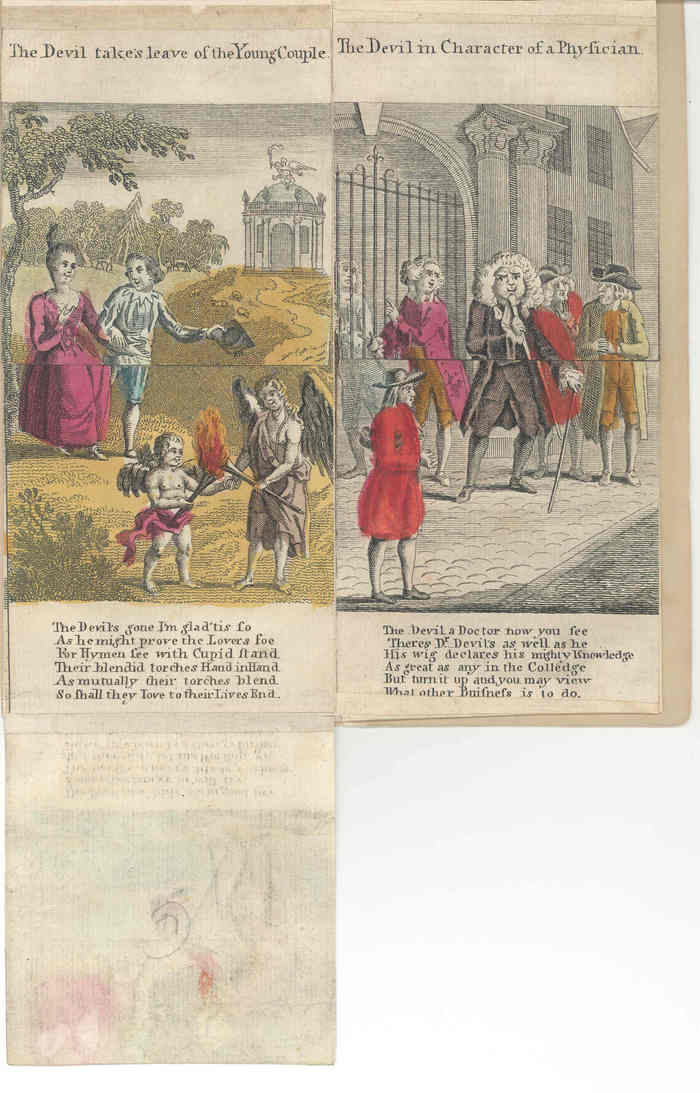
Harlequinade Harlequinade Turn-up: Mother Shipton. Image courtesy of Lillian H. Smith Collection, Osborne Collection, Toronto Public Library.CLOSE or ESC
Harlequinade turn-ups exemplify transitional media.33 Like all books containing flaps, Harlequinade turn-ups are designed with interactive readers in mind. While the level of participation is entirely conditional on a reader’s willingness to interact, the meaning enclosed beneath the turn-ups is fully realized only when a reader participates. The participatory aspect of Harlequinade turn-ups also extends to the performances by which they were inspired. The demanding voice of the narrator, who orders readers to “Turn it up and you may view. . .” or “Turn down, you’ll find the ready way,”34 asserts its dominance over the story. Shunned by the more refined sectors of British society, pantomimes were a raucously participatory experience for both the actors, who collaborated without a published script, and the audience members, who were encouraged to give critical feedback to the performers and behave as active participants.35 In this sense, viewers were given control over the details, though not the eventual outcome of the story, which is similar to how readers interact with the flaps found in turn-up books.
In the 1820s there emerged yet another type of flap book with a physical structure similar to that of Descartes’s De Homine, in which a flap, cut from the main page, lifts to reveal the image pasted beneath. While devising a party favour, painter William Grimaldi noticed the wide assortment of items collected on his daughter’s dressing table. The collection would inspire Grimaldi to produce his work The Toilet. In this work, Grimaldi sketched each individual item on the upward-facing part of the flap, along with the name of a corresponding virtue beneath. The image of a container of Rouge Superieur opens to reveal the word “Modesty”;36 the example shown below (see figs. 10-11) depicts a jewelry box with an opening to the word “Attention.” That these small books became such popular party favours despite the stern reminders hidden beneath each feminine trinket is a testament to the sensibilities of the time; clearly moral virtue was held in very high esteem if an acceptable party game could be based wholly on the rebuke of objects that risked violating carefully guarded values. Grimaldi’s The Toilet, published by his son Stacey, became very popular, and spawned various imitations. Most notable among these was Indispensible Requisites for Dandies of Both Sexes, written by an unnamed Irish woman known only as “A Lady”:37 in her work readers see flaps with captions, but when they lift the flaps they find double entendres relating to those captions. For example, a caption reading “Oriental Head Dress” appears above a flap image of a woman wearing an elaborate hat; upon lifting the flap, the reader finds the words “Sobriety of mind.” Grimaldi’s son Stacey, acting as publisher and co-author, urged Grimaldi toward his eventual follow-up: A Suit of Armour for Youth. While following the same structure and principle as his previous work, but nesting moralizing aphorisms beneath pieces of armour, Suit of Armour proved far less successful.
Figure 10

Click For Larger Image
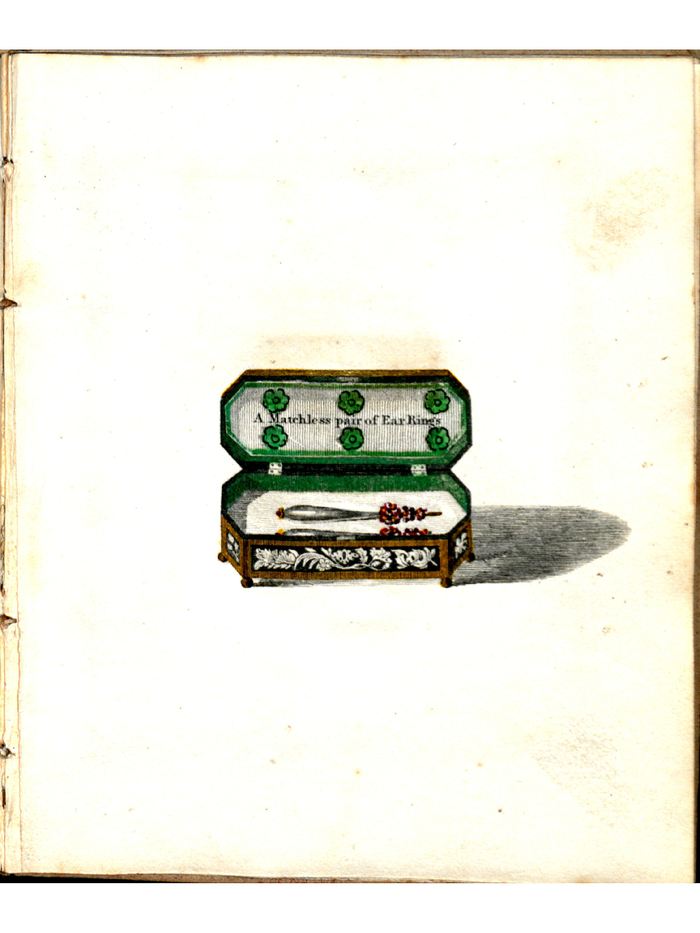
Flaps in Entertainment Literature, 1 Grimaldi's The Toilet, earring flap, shut. Image courtesy of Lillian H. Smith Collection, Osborne Collection, Toronto Public Library.CLOSE or ESC
Figure 11
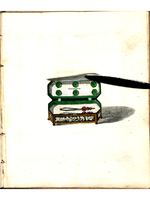
Click For Larger Image
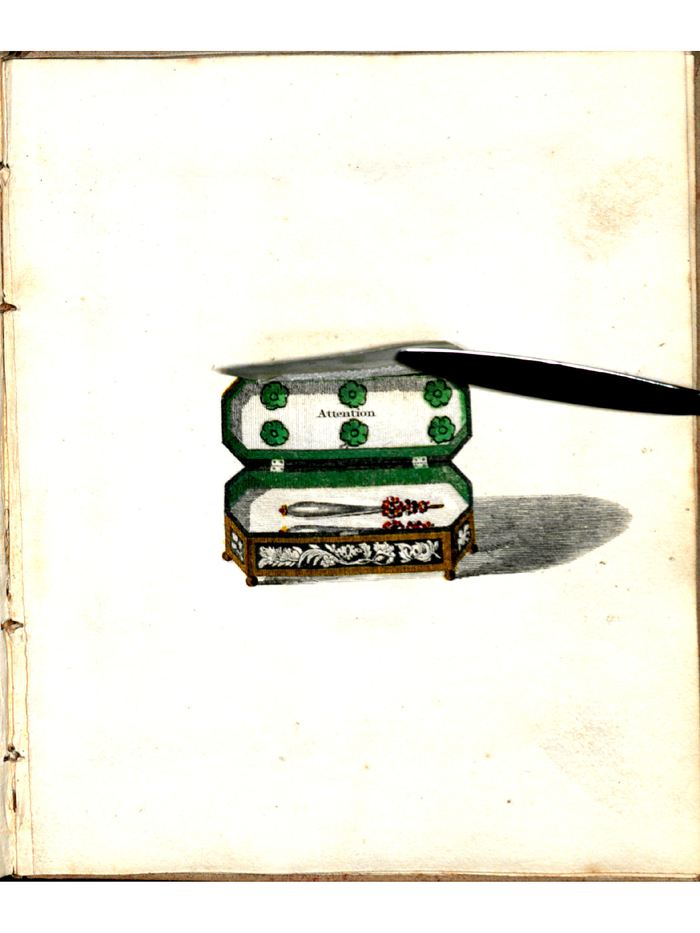
Flaps in Entertainment Literature, 2 Grimaldi's The Toilet, earring flap, open. Image courtesy of Lillian H. Smith Collection, Osborne Collection, Toronto Public Library.CLOSE or ESC
These and other examples of “Toilet Books” characterize the intersection between entertainment and the dissemination of popular morality. The flaps make this duality all the more interesting because the reader cannot see or absorb these moral teachings without willingly lifting each flap. The placement of the text beneath the flap allows the reader to form his or her own interpretation of the surface image, even though the underlying, fixed meaning is uninfluenced by reader opinion. The moral pronouncements are permanent; whether the reader is willing to accept them is less certain.
Flaps, then, exist at the intersection of education and entertainment. Grimaldi’s work, while explicitly moralizing, was designed as a party favour.38 The before-and-after nature of the Harlequinades, “Toilet Books,” and Repton’s landscaping designs teaches the reader while also eliciting surprise and delight; Euclid’s geometric shapes similarly promote play-like building and crafting. While the anatomy books offer a more rigorous subject matter, the investigatory quality permitted by the flaps within them is entertaining. The descent through the human body is essential to our fundamental understanding of anatomy, and that journey is made possible through the use of flaps.39
Flaps represent an early interactive interface. By creating a deeper level of visual and tactile understanding for the reader, flaps further enhance a book’s educational and entertainment value. The existence of flaps and other movable parts in centuries-old books reminds us that reader interaction is not a new phenomenon, and that an interactive component, or an interface, has been a part of books long before the invention of digital media. The well-established connection between seeing and understanding has long influenced how we communicate, teach, and present information; by drawing on the relationships between the visual, the cognitive, and the tactile, flaps exemplify interactive and multifaceted learning tools, and remind us of the continuing challenge to communicate not only through words, but also through images and reader interaction. In the digital environment flaps also permit such reader interaction, although the physical contact between reader and page is replaced by a click of the mouse or a touch-screen; further, the digitization of flaps would eliminate the potential for loss or physical damage. The digital environment is more dynamic than print, and motion is both more easily accomplished and less traumatic for the page. However, the digital interface also acts as a mediator where previously none existed; technical incompatibilities such as the reader’s chosen operating system or limited bandwidth for online materials may prohibit their use of the book’s movable components.40 A reader’s experience with a print volume is, of course, free from such complications; however, while technical incompatibilities can often be adjusted, a ruined print book is less salvageable.
Though digital environments have drastically redefined the power and potential of text, the idea of movement, user interaction, and pushing the boundaries of an otherwise static page has a long and varied history that is well worth examining and learning from. Flaps are but one part of that important history.
Ball, James Moore. Andreas Vesalius, the Reformer of Anatomy. Saint Louis: Medical Science Press, 1910.
Carlino, Andrea. Paper Bodies: A Catalogue of Anatomical Fugitive Sheets. Translated by Noga Arika. London: Wellcome Institute for the History of Medicine, 1999.
Daniels, Stephen. Humphry Repton: Landscape Gardening and the Geography of Georgian England. New Haven, CT: Yale University Press, 1999.
Haining, Peter. Movable Books: An Illustrated History. London: New English Library, 1979.
Hotchkiss, Valerie, and Fred C. Robinson. English in Print: From Caxton to Shakespeare to Milton. Chicago: University of Illinois Press, 2008.
"Johann Remmelin's Catoptrum Microcosmicum." Hardin Library. Accessed March 18, 2011. https://wayback.archive-it.org/823/20160325192432/http://sdrc.lib.uiowa.edu/exhibits/imaging/remmelin/index.html.
Karr Schmidt, Suzanne. Altered and Adorned: Using Renaissance Prints in Daily Life. New Haven, CT: Yale University Press, 2011.
Lindberg, Sten G. "Mobiles in Books: Volvelles, Inserts, Pyramids, Divinations, and Children's Games." Translated by William S. Mitchell. The Private Library, 3rd series, 2.2 (Summer 1979): 49-82.
McGrath, Leslie A. This Magical Book: Movable Books for Children, 1771-2001. Toronto: Coach House Press, 2002.
Montanaro, Ann. "A Concise History of Pop-up and Movable Books." Rutgers University Libraries. Accessed February 19, 2012. http://www.libraries.rutgers.edu/rul/libs/scua/montanar/p-intro.htm.
Mother Shipton. London: Strutt, Burns, and Newbery, 1800.
Oldfield, Philip, and Richard Landon. Ars Medica: Medical Illustration Through the Ages. Toronto: Thomas Fisher Rare Book Library, 2006.
Paper Engineering: Fold, Pull, Pop & Turn. Washington DC: Smithsonian Libraries Exhibition Gallery, National Museum of American History, 2010. http://www.sil.si.edu/pdf/FPPT_brochure.pdf.
Pettegree, Andrew. The Book in the Renaissance. New Haven, CT: Yale University Press, 2010.
Pozeg, Zlatko I. and Eugene S. Flamm. "Vesalius and the 1543 Epitome of his De humani corporis Fabrica librorum: A Uniquely Illuminated Copy." Papers of the Bibliographical Society of America 103.2 (2009): 199-220.
Reid-Walsh, Jacqueline. "The Late 18th Century Harlequinade: A Migration from Stage to Book." ICS Leeds Communications Research. May 2005. [Online paper no longer available.]
Repton, Humphry. Observations On the Theory and Practice of Landscape Gardening. London: Taylor, 1803.
Rubin, Ellen G.K. "Pop-up and Movable Books in the Context of History." 2005. The Pop-Up Lady. Updated 2019. https://popuplady.com/about-pop-ups/pop-up-and-movable-books-in-the-context-of-history/.
Slights, William W. E. The Heart in the Age of Shakespeare. Cambridge: Cambridge University Press, 2008.
Speaight, George. "Harlequinade Turn-Ups." Theatre Notebook 45.2 (1991): 70-84.
Wilkin, Rebecca M. "Figuring the Dead Descartes: Claude Clerselier's Homme De Rene Descartes (1664)." Representations 83.1 (2003): 38-66.
